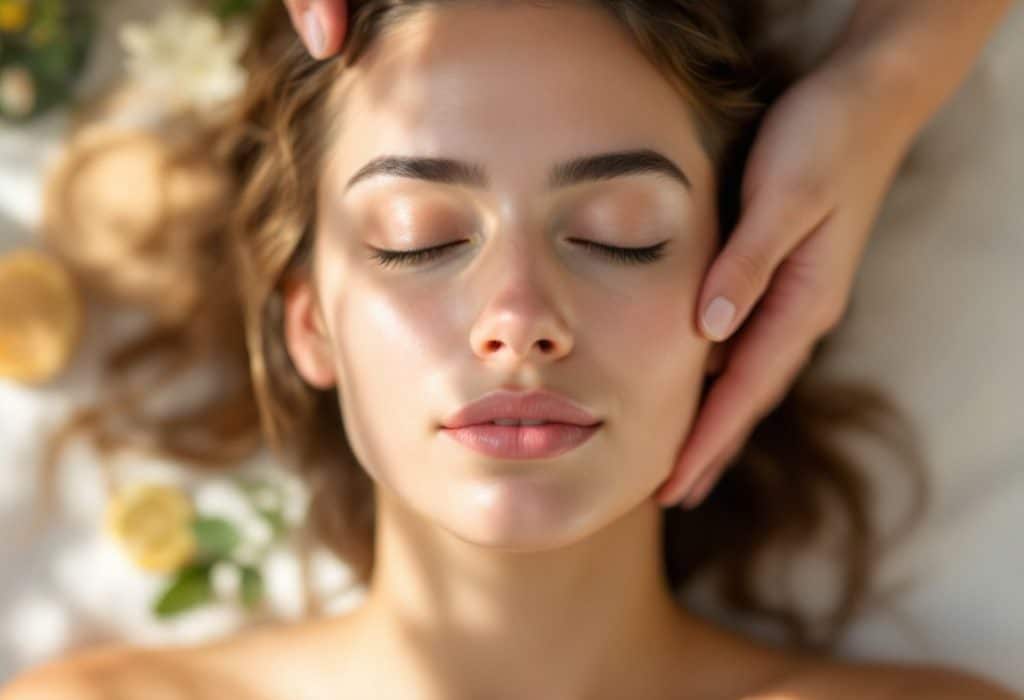In an increasingly hectic world, the quest for tranquility begins right at home. Your daily skincare routine can be transformed into a ritual of mindfulness, effectively acting as a sanctuary for your soul. But how exactly do you integrate mindfulness into skincare, and why is it so pivotal? Let’s dive in to build a practice that not only nurtures your skin but also calms your mind. For those interested in a comprehensive guide, explore the mindful skin care at home routine.
The Intersection of Skincare and Mindfulness 🌿
Integrating mindfulness into your skincare routine isn’t just a wellness fad. It’s a science-backed approach that enhances emotional well-being and promotes healthier skin. Researchers have acknowledged the positive impacts of mindfulness on stress reduction and mental clarity, which, in turn, can reflect positively on your skin. A study published in the *Journal of Behavioral Medicine* found that mindfulness practices reduce cortisol levels, a stress hormone known to cause acne flare-ups and premature aging. To further understand how stress and lifestyle factors affect skin, explore the connection between gut health and skin aging.
Mindful skincare practices allow you to enjoy not only the tactile benefits of the ingredients but also the serene mental space crafted from these thoughtful rituals. Now, let’s explore specific mindful skincare strategies that promise inner peace and healthier skin.
Establishing Your Home Sanctuary
Creating a space conducive to mindfulness begins with setting up your environment. To effectively incorporate skincare at home, you must prepare an environment that stimulates peace and introspection.
1. Creating the Ideal Setting
Start with decluttering your space. A clean, organized area devoid of distractions can help channel your focus inward. Use calming elements such as soft lighting, soothing colors, and relaxing music. Essential oils like lavender or chamomile, known for their calming properties, can elevate your environment into a serene sanctuary.
2. Curating Your Skincare Arsenal
Focus on quality over quantity. An effective skincare routine does not require a myriad of products—select items that are both efficacious and nurturing. When choosing products, consider those with natural, non-irritating ingredients. For instance, learn about effective anti-aging ingredients that really work to enhance your routine. Studies from the Environmental Working Group (EWG) reveal that exposure to certain chemicals often used in cosmetics can result in allergic reactions or irritate sensitive skin. Always patch-test new products to ensure they’re suitable for your skin type.

3. Setting a Routine That Respects Your Rhythm
Mindful skincare is all about aligning your routine with your body’s natural dynamics. Studies published in the *Journal of Clinical and Aesthetic Dermatology* highlight the importance of respecting skin’s circadian rhythms, which involve adjusting your skincare regimen according to the time of day. Morning routines should focus on protection and hydration, using products like antioxidants and SPF, while nighttime is for repair and rejuvenation. Discover more about anti-aging tools for home use that can complement your evening routine.
Mindful Skincare Practices: Technical Insights and Applications
Compostive awareness is at the heart of mindful skincare. By paying attention to each step, you develop a deeper connection with your regimen, enhancing both its efficacy and enjoyment.
1. Cleansing With Intention 🧼✨
Proper cleansing is the cornerstone of effective skincare. In terms of mechanics, opt for a gentle cleanser suitable for your skin type. While applying, use circular motions—a technique that not only breaks down oils effectively but also promotes lymphatic drainage to reduce puffiness. During cleansing, focus on the sensation of the water and texture of the cleanser. Be present at the moment and visualize the day’s stress and impurities washing away. Consider the evidence from dermatology studies that stress an effective cleanser’s role in preparing the skin to absorb other products more efficiently.
2. Mindful Application of Treatments
The meticulous application of treatments like serums and moisturizers anchors the mindfulness practice within your regimen. Clinical peptide serums are lauded for their properties in boosting collagen and elastin, offering not just firm skin but a tactile, rejuvenating sensation during application. Take your time to gently massage these treatments, perhaps five minutes each, enhancing absorption and blood flow. Just as a seasoned chef relishes every step of the culinary process, revel in the sensory experience—the texture of the serum or moisturizer, the fragrance—as you imagine it nourishing your skin. To explore products that can enhance your regimen, discover the best anti-aging skincare products of 2024.
3. Incorporating Facial Massage Techniques
Scientific studies support the benefits of regular facial massage, which include improved muscle tone, reduced stress marks, and stimulation of circulation. Techniques like gua sha or face rollers have gained popularity, guided by traditional Chinese medicine principles.

Use a jade roller, for instance. The chill of the stone not only feels refreshing but also reduces inflammation—a well-documented benefit in the *Journal of Geriatric Dermatology*. Stroke it gently along your face, starting from the center and moving outward. Synchronize your breathing with the motion, visualizing each stroke washing away anxiety and tension.
4. Ritual of Relaxation: Face Masks
Face masks are not just for their cosmetic benefits but as pivotal tools in your mindfulness repertoire. Masks lock moisture into your skin while providing a tangible pause in your day—a step where you can practice patience and deep breathing. Choose masks infused with soothing ingredients—like aloe vera or chamomile—that are backed by research for their efficacy in calming irritated skin. Create a routine: while the mask sets, indulge in 15 minutes of meditation or soft reading. Crafting this pause trains your mind towards calm reflection, truly integrating skincare with inner peace.
Integrating Self-Care Rituals
True mindful skincare is holistic. Consider the physiological effects of stress on your skin, as highlighted by the American Psychological Association: stress triggers responses that can exacerbate skin conditions like eczema, psoriasis, and acne. Hence, integrating a mindful routine can holistically care for your emotional and physical well-being.
Emotional Wellness Through Skincare
Your skincare mantra should incorporate positive affirmation—repeating phrases like “I am nurturing my body with love” while applying products is rooted in the psychology of self-compassion. This element of positivity helps foster an enhanced sense of self-worth and serenity. For more insights, check out the anti-aging protocol for dancer skin, focusing on emotional and physical harmony.
Evening Unwind Techniques
Turn your nighttime routine into an unwinding ritual. Consider ‘sleepen rituals,’ which include night-time yoga to cultivate bodily mindfulness—a practice that reduces stress and optimizes rest. Dr. Sarah Hughes, a leading cognitive behavior psychologist, asserts that physical relaxation techniques greatly enhance skincare benefits by reducing inflammatory responses known to compromise the skin’s barrier function.
Real-World Application: Mindful Observations and Adjustments

Mindful skincare encourages adaptive behavior based on observant practices. Just as patience heals, adapt your practices based on mindful observations of your skin’s daily condition—incorporating more hydration during dry conditions or dialing back rich creams when congestion arises. For an in-depth understanding of how hydration affects your skin, explore the science of skin hydration.
1. Maintaining a Skin Diary 📝
A research-validated technique is maintaining a skin diary, assisting you to track responses, making informed product choices, and creating bespoke regimens. Chronicle aspects like product changes, mood variations, and physiological responses, tying together the mind-skin connection.
2. Environmental and Internal Factors
Conduct regular ‘environmental checks’—how is humidity affecting your skin, or is stress at work causing breakouts? These adjustments highlight the core of mindful practice: responsiveness and adaptation, creating pathways to uninterrupted peace and epidermal health.
Reflecting on Your Journey 🧘♂️
Establishing a mindful skincare routine takes patience and conscious effort. Celebrate small victories, like noticing an enhancement in your skin’s texture or realizing an overall better mood. These observations are critical indicators that affirm your integrated practices are beneficial.
In conclusion, embracing mindful skincare at home revolves around not just luxurious routines, but forging a resilient connection between the mental and physical facets of well-being. By embedding simple practices that respect both mind and skin, you instill an oasis of tranquility into the everyday—a meaningful endeavor that not only radiates through clearer, healthier skin but echoes into a serene, peaceful existence.
In these mindful moments, you’ll find the ultimate reflection of self-care rituals: renewed skin, renewed spirit. 🧴💆♀️
—
References
- “Mindfulness-Based Stress Reduction and Health Benefits: A Meta-Analysis” from Journal of Behavioral Medicine
- “Environmental Work Group’s Skin Deep Database”
- “Journal of Clinical and Aesthetic Dermatology” on skin circadian rhythms
- “American Psychological Association” on physiological effects of stress on skin
Frequently Asked Questions
What are the benefits of using a hair mask in my hair care routine?
Using a hair mask can provide several benefits, including hydration, smoothing, strengthening, curl definition, heat protection, and damage repair. Hair masks infuse the hair with moisture, help coat the hair shaft to seal split ends, reduce breakage, and protect the hair from heat styling and environmental damage[1][4].
What ingredients should I look for in a hair mask?
Effective hair masks often include ingredients such as coconut oil, argan oil, shea butter, honey, avocado oil, green tea, and coconut water. These ingredients provide nourishment, moisturize, and protect the hair, offering benefits like softening, moisturizing, and protecting against damage[2][5].
How often should I use a hair mask in my routine?
You should use a hair mask whenever your hair feels dry, unmanageable, or in need of intense hydration. This can vary depending on your hair type and needs, but generally, using a hair mask once or twice a week can help maintain healthy and moisturized hair[1][4].
How do I apply a hair mask for the best results?
To apply a hair mask effectively, shampoo your hair first, then apply the mask, focusing especially on the ends where hair tends to be the most damaged. Leave the mask on for anywhere from 10 minutes to overnight, depending on the type of mask and your hair’s needs[1][4].
References


